
Tortosa is the capital of the comarca of Baix Ebre, in Catalonia, Spain.
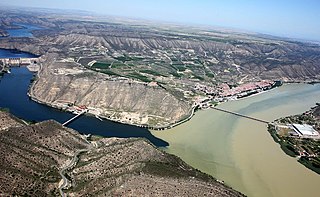
Bajo Cinca or Baix Cinca is a comarca in eastern Aragon, Spain. It is named after river Cinca.
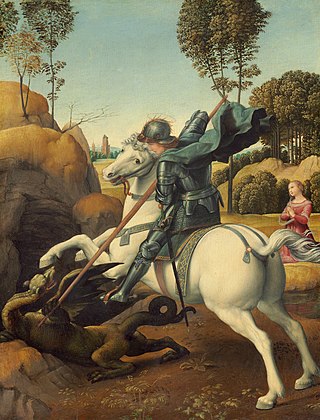
Saint George's Day is the feast day of Saint George, celebrated by Christian churches, countries, regions, and cities of which he is the patron saint, including Albania, Bulgaria, England, Ethiopia, Greece, Georgia, Portugal, Romania, Syria, Lebanon, Castile and León, Catalonia, Alcoi, Aragon, Genoa, and Rio de Janeiro.

Moros y Cristianos or Moros i Cristians, literally in English Moors and Christians, is a set of festival activities which are celebrated in many towns and cities of Spain, mainly in the southern Valencian Community. According to popular tradition the festivals commemorate the battles, combats and fights between Moors and Christians during the period known as Reconquista. There are also festivals of Moros y Cristianos in Spanish America.

Our Lady of Montserrat or the Virgin of Montserrat is a Marian title associated with a statue of the Madonna and Child venerated at the Santa Maria de Montserrat monastery on Montserrat mountain in Catalonia, Spain. She is the patroness saint of Catalonia, an honour she shares with Saint George. Miracles have been attributed to the statue.

Sant Feliu de Llobregat is an industrial city and municipality in Catalonia, Spain, in the province of Barcelona. It is the capital of the comarca of Baix Llobregat, and the see of a bishopric since June 2005.

Catalans are a Romance ethnic group native to Catalonia, who speak Catalan. The current official category of "Catalans" is that of the citizens of Catalonia, a nationality and autonomous community in Spain and the inhabitants of the Roussillon historical region in southern France, today the Pyrénées Orientales department, also called Northern Catalonia and Pays Catalan in French.
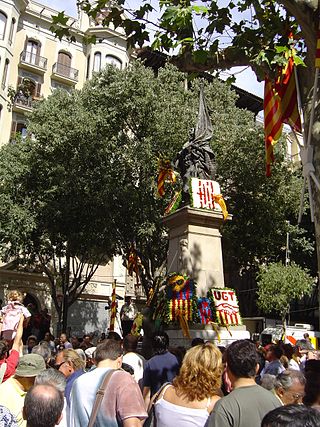
The National Day of Catalonia is a day-long festival in Catalonia and one of its official national symbols, celebrated annually on 11 September. It commemorates the defense against the siege of Barcelona during the War of the Spanish Succession in 1714 and the subsequent loss of Catalan institutions and laws.
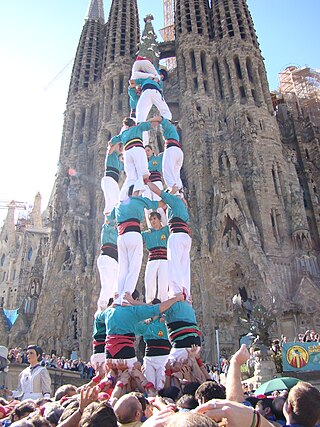
There are quite a number of festivals and traditions in Catalonia (Spain). While most are of ancient origin, certain traditions are of relatively recent introduction. There are also some that are common to the whole Catalan society, but others are relevant only to a particular location. Generally, locals welcome outsiders to share with them in their celebration.

Sant Sadurní d'Anoia is a municipality in the comarca of the Alt Penedès in Catalonia, Spain; and the centre of production of a sparkling wine known as cava. It is situated in the north-east of the Penedès Depression at the confluence of the Avernó river and the Anoia river. It is accessible by the AP-7 autopista and the Renfe railway line (R4) that connect Barcelona with Manresa and El Vendrell.

The flag of Barcelona is the municipal flag of Barcelona, which combines the cross of Saint George, the patron saint of Catalonia, with the traditional red and yellow bars of the Senyera, the ancient symbol of the Crown of Aragon.
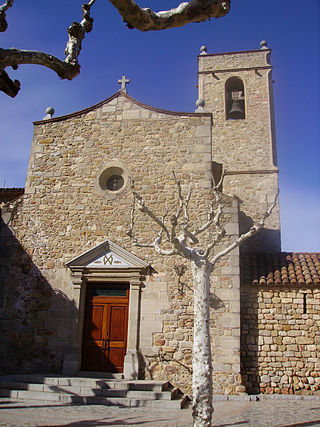
Òrrius is a village and municipality in the comarca of Maresme in the province of Barcelona and autonomous community of Catalonia, Spain. The municipality is delimited by La Roca del Vallès to the North, Vilassar de Dalt to the South East, Argentona to the south, and Cabrils to the southwest.

The national symbols of Catalonia are flags, icons or cultural expressions that are emblematic, representative or otherwise characteristic of Catalonia or Catalan culture.

The Assemblea Nacional Catalana is an organization that seeks the political independence of Catalonia from Spain. It also promotes the independence of other Catalan-speaking regions, which are collectively known as the Catalan Countries.

The 2012 Catalan independence demonstration was a protest which occurred in central Barcelona in Catalonia, Spain, on 11 September 2012 during the National Day of Catalonia. The protestors demanded the independence of Catalonia and its establishment as a sovereign state under the slogan "Catalonia, new state in Europe". It was organized by the Catalan National Assembly (ANC) and headed together with the Association of Municipalities for Independence as the most prominent of a series of events known as "March towards Independence" which began on 30 June 2012 in Lleida.

The Catalan Way, also known as the Catalan Way towards Independence, was a 400-kilometre (250 mi) human chain in support of Catalan independence from Spain. It was organized by the Assemblea Nacional Catalana (ANC) and supported by 14 nongovernmental groups. It took place in Catalonia on 11 September 2013, which is the National Day of Catalonia, known as Diada. Catalonia's Department of the Interior estimated the number of participants at about 1.6 million. The human chain followed the ancient Via Augusta, from Le Perthus up to Alcanar. According to Carme Forcadell, president of the ANC at that time, it was "a symbol of the unity of Catalan people to achieve national sovereignty".

National Day for Yes was a gathering in Barcelona on 11 September 2017, the National Day of Catalonia, in support of Catalan independence. It was organized by the Catalan National Assembly (ANC), the main civil society organisations behind the massive pro-independence demonstrations held since 2012.

The coat of arms of Barcelona is the official emblem of the City Council of Barcelona, the capital of Catalonia, has its origin in the Middle Ages, these arms were first documented in 1329. The Government of Catalonia conferred the coat of arms and the flag as official symbols of the municipality in 2004. It has an escutcheon in lozenge which is commonly used in municipal coats of arms of cities in Catalonia. Currently the City Council of Barcelona also uses an isotype based on the heraldry of the city.
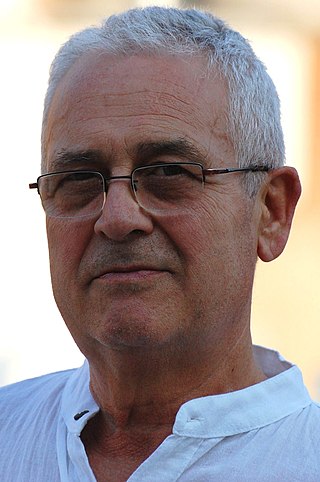
Joan Soler i Amigó was a Spanish writer and teacher.

The Day of Books and Roses, April 23, is celebrated in Catalonia, Spain. This day is traditionally known as Diada de Sant Jordi in Catalan. On this day, love and literature are celebrated throughout Catalonia. Books and roses are exchanged.























